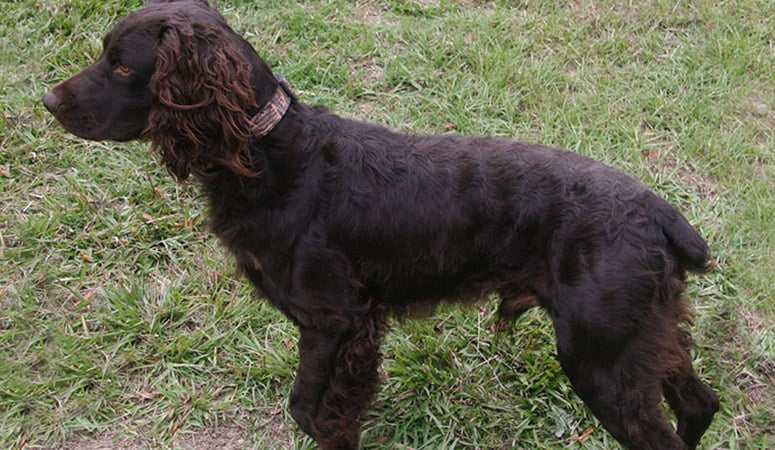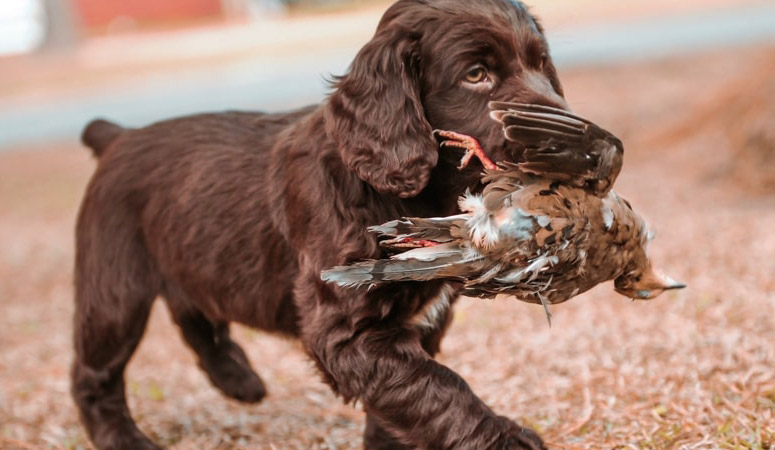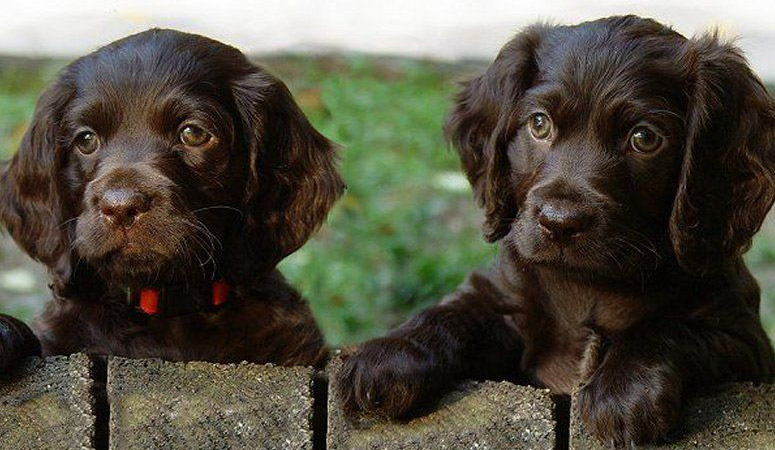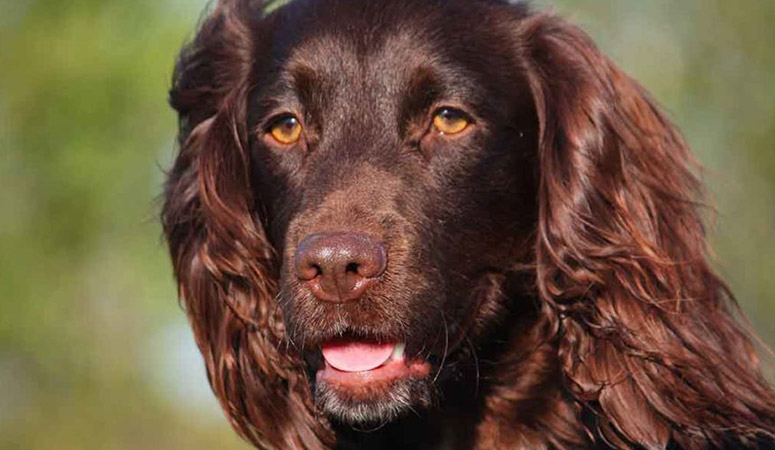Boykin Spaniel
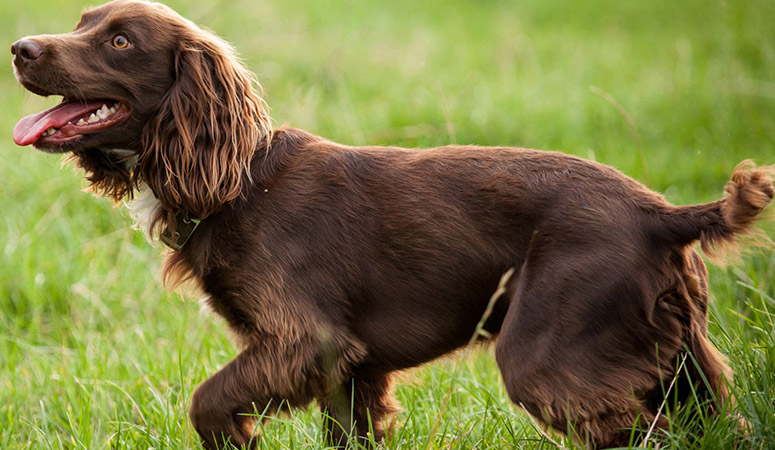
Originated in the United States and developed in South Carolina, Boykin Spaniel is medium-sized flushing and retrieving dog with a rich brown coat. They are noted for their hunting skills, also, they can be good companions to families as well as hunters because of their intelligence and friendliness.
| Other Names | Boykin, Swamp Poodle, LBD (Little Brown Dog) |
| Color | Liver |
| Height | Males: 15-18 inches. Females: 14-17 inches. |
| Weight | Males: 30-40 pounds. Females: 25-35 pounds. |
| Life Span | 10-15 years |
| Personality | Friendly, Eager, Lovable |
| Exercise | Regular Exercise |
| Origin |
| Popularity | #89 |
| Groom Needs | 2-3 Times a Week |
| Kids Friendly | Yes |
| Dog Friendly | Yes |
| Watch Dog | |
| Family Dog | Yes |
| Litter Size | 5-7 |
Boykin Spaniel Pictures
Boykin Spaniel Video
Introduction
Ranked 100th most popular dog breed by the American Kennel Club is the friendly, affectionate, and exuberant Boykin Spaniel. It was developed into a flushing dog, especially for waterfowls and turkeys, and has not only lived up to that reputation but is also admired, more recently, as an excellent house dog. They are sheathed in a coat of medium length which is often straight, although slightly curly. Solid, rich liver or dark chocolate are the main color varieties of this sporting dog.
Boykin Spaniels are medium-sized dogs, being slightly larger than the English Cocker Spaniels. A full-grown male is usually 15-19 inches tall, measured at the shoulder, while a similar female measures around 14-17 inches. The male type runs heavier than the female; tipping the scales at 30-40 pounds, where the female manages 23-36 pounds. Boykin Spaniels have an average life expectancy of 10-14 years.
Living with Boykin Spaniel
The Boykin Spaniel has a medium-length, wavy coat that requires only minimal maintenance. Brushing their rich brown coat once a week would help to remove dirt and loose hair and keep the dog look best. A bath once a month, or whenever they get dirty, will keep the dog clean-smelling and healthy. Or you can take your dog to a professional groomer to clip the coat as needed for neatness if you want.
Brush your dog’s teeth several times a week for good overall health and fresh breath. And check the ears every week for dirt, redness, or a bad odor that may indicate an infection. Besides, trim the nails every month to prevent painful cracking.
Boykins have moderate to high energy and require lots of exercise about an hour or two of daily physical activity to remain fit and well behaved every day. And a daily regular exercise is helpful to keep the dog happy and healthy, which could be in the form of long walks and play sessions.
Boykin Spaniel is a good companion for jogging and is very happy to accompany his family in any outdoor activities, including outdoorsy exercise and play. Also, Boykin Spaniel can participate in obedience, tracking, agility, rally, field events, and other activities to exercise mind and body.
They are most suitable for active people, especially those who seek sports partners to participate in activities such as hiking, running, or cycling.
Generally, it is recommended to feed a Boykin Spaniel with one and a half to two and a half cups of high-quality dry dog food every day, divided into two meals. More importantly, the food amount should depend on the dog’s weight, size, age, and activity level. There should be fresh and clean water at all times.
Some dogs are easy to get overweight, so you need to watch their calorie consumption and weight level all the time. Treats may be an important aid in training, but excessive intake can lead to obesity. Also, owners need to distinguish which human food is safe for dogs and which are not. If you have any problems with your dog’s weight or diet, just consult from your veterinarian.
Boykin Spaniels are prone to the following health conditions: hip dysplasia, hypothyroidism, elbow dysplasia, patella luxation, endocrine disorders, Cushing’s syndrome, heart problems, hemophilia A, pulmonic stenosis, eye problems, including juvenile cataracts and distichiasis, etc.
Major concerns: patellar luxation, CHD
Minor concerns: cataract
Occasionally seen: exercise induced collapse, pulmonic stenosis
Suggested tests:
EIC DNA Test
Hip Evaluation
Patella Evaluation
Ophthalmologist Evaluation
Collie Eye Anomaly (CEA) DNA Test
Total Annual Cost: $2889
Cost is estimated for the first year and may vary depending on many factors, such as dog food, health care, leash, collar, licensing, possible fencing, crates, training and obedience classes, dog-walking, grooming, treats, toys, flea, tick, and heart-worm meds, microchips, etc.
Intelligent and eager to please, Boykin Spaniels are considered easy to train but only under the proper time and effort that the owner invests. And this breed may be sensitive, so it is recommended to use positive dog training methods such as praise and rewards to ensure the best results. With patient training, the smart and alert Boykin Spaniel is a highly biddable dog. It is necessary to keep lessons fun and interactive to ensure your dog to learn the basic commands quickly. Besides, it is a good option for the Boykin Spaniel to take advanced training as they are kept active. They could excel in agility, dog sports, swimming, and advanced obedience.
History
The Boykin Spaniel is one of the all-American bred dogs with a history that started in the 20th century. Stories are told of how a banker of South Carolina, Alexander L. white found a stray spaniel dog in front of a churchyard where he attended services at Spartanburg, South Carolina. White liked the dog, so he took it home, and named it Dumpy. When he went hunting with the dog, alongside his own retriever dogs, he found that Dumpy had a natural instinct for hunting waterfowls and ducks, even more than his own dogs. White responded to this discovery by sending the dog out to be trained and worked upon by a friend of his, Lemuel Whitaker “Boykin”, who was a fellow breeder and hunter.
This dog, which later formed the foundation of the Boykin Spaniel was crossed several times with other spaniels and retrievers, including the Cocker Spaniel, Chesapeake Bay Retriever, American Water Spaniel, Springer Spaniel, and various pointing breeds. Whit took into account the size of the dog, as such a retriever dog for hunting was supposed to be small enough to enter the little boats used for hunting in the swamps of Campden, South Carolina, where it was developed. The Boykin Spaniel, hence, emerged with the remarkable features which caught the attention of the neighborhood and its visitors, and soon the breed began to grow in popularity.
Boykin Spaniel Society (BSS) was founded by the family for which the breed was named, in 1979. Although the BSS closed its Studbook in 1980, the United Kennel Club still recognized the Boykin Spaniel, later in 1985. The breed became fully recognized by the American Kennel Club in 2009.
Helpful Information
Breed Club: BOYKIN SPANIEL CLUB & BREEDERS ASSOCIATION OF AMERICA
Breed Club Link: http://theboykinspanielclub.com/
Breed Club Rescue: Boykin Spaniel Rescue, Inc.
Breed Club Rescue Link: https://www.boykinspanielrescue.org/

